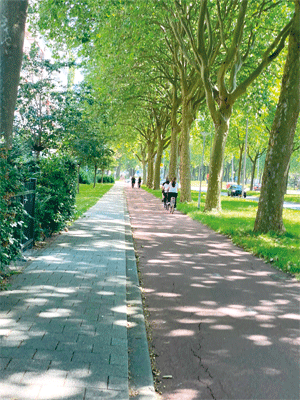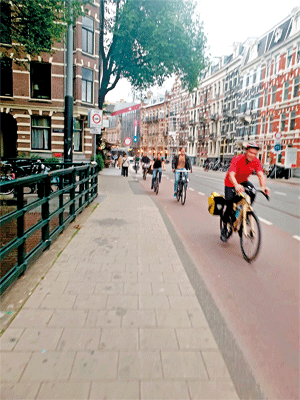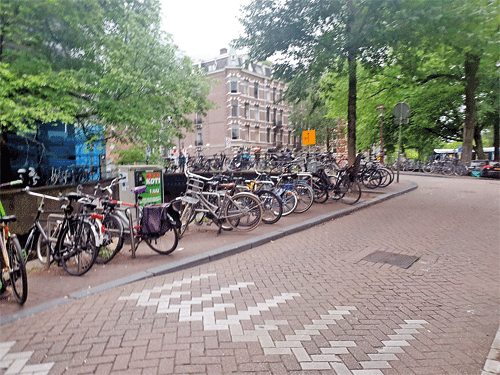On a bicycle made for you: Can we go the Dutch way?
The bicycle offers an affordable, comfortable, easy and sustainable way of human mobility for rich and poor alike. As problems related to congestion in the cities in the emerging world continue to grow, investing in facilities for cycling as a clean, healthy alternative to motorbikes and cars can help reduce congestion and pollution. It will also provide access to cheap transportation in countries where up to a quarter of a person’s income is currently spent on mobility.
So can we transform Sri Lanka (starting with Colombo and other major cities) into a cycling nirvana by following in the footsteps of the Netherlands?

Bike friendly: Cyclists in the Netherlands and right, ample parking facilities’
A cyclist’s heaven
Cycling is a symbol of Dutch culture. The Netherlands holds the world record as the nation with the most bicycles per capita. With 23 million bicycles for 17.4 million inhabitants, 32,000 kilometres of bicycle lanes and the largest bicycle parking facilities in the world, the Netherlands could absolutely claim to be the world’s No. 1 cycling country.
The Dutch have built a cycling culture accessible to everyone, regardless of age, ability, or economic means. Cycling is a common mode of transport in the Netherlands, with 36% of Dutch people listing the bicycle as their most frequent way of getting around on a typical day, as opposed to the car (45%) and public transport (11%). Cycling has a modal share of 27% of all trips (urban and rural) nationwide. The Dutch train their children to ride so they can confidently ride on the roads when they are around 12 years of age. Dutch motorists are also trained for interaction with cyclists as part of their driver training.
Amsterdam is well known as the cycling capital of the world but it is important to remember that the Dutch overcame many of the same challenges as other car-clogged countries, and their story is an important model for moving the rest of the world toward a more human-scale, bike-friendly future. An increase in the car ownership in the 1950s and ’60s caused an increased number of incidents on the road and subsequently deaths. Data showed that in 1972, more than 3,000 people were killed by motor vehicles – 450 of them children. A social moveme By Dr. Prasanna J.P. Gunawardena nt ‘Stop de Kindermoord’ (Stop the Child Murder) began – demanding safer cycling conditions for children. The Middle East oil crisis of 1973 also increased the pressure on the Dutch government to introduce improvements in cycling infrastructure.
The Dutch built a dedicated vast network of cycle paths to make cycling safer. The road is usually marked with red smooth surfaces. The cycle paths are wide enough to allow side-by-side cycling and overtaking. The needs of cyclists are considered in all stages of urban planning. Urban areas are frequently organised as ‘living streets’, which prioritise cyclists and pedestrians over motorised traffic.
 How to make your
How to make your
city cycle friendly
The main factor that keeps cycling rates low in many cities is that most people are not comfortable sharing space with fast-moving cars and trucks.
Most modern cities are designed for the car. Whether it’s the driveways of our homes, or parking spots, everything is designed to make travelling by car as easy as possible, with little thought of cyclists. In most cities, for instance, roads have no separate cycle lanes.
Any city can become a cycling city. However, there must be an understanding that streets have to be designed for all trips, not just the one to work. This means connecting where people live to shops, community centres, schools, parks – places people actually want to go. Think bicycle parking, bike-public transportation connectivity, and thoughtfully designed signage and traffic signals for way finding and ease of use.
Strategies for successful
implementation
1) Extension and improvement of the bicycle networks and network connectivity of different sections to make all areas accessible by non-motorised transport modes;
2) Improvement in the comfort and safety of bicycle lanes as well as adaptation of road infrastructure (e.g., junctions, crossings) and traffic signs to give cyclists priority and safer journeys
3) Offering additional bicycle services like safe and comfortable parking and transfer facilities, repair shops, rental systems, or accommodation on public transport vehicles
 4) Stimulating the use of electric bicycles, e.g., by offering information, charging points or special incentives
4) Stimulating the use of electric bicycles, e.g., by offering information, charging points or special incentives
5) Information and marketing campaigns to influence citizens’ travel behaviour
6) Offering training courses for safer cycling.
By favouring cycling in a city, the use of private cars can be decreased. Consequently, air pollution and the need for parking spaces will decline, giving the possibility of being able to reconstruct and re-use public spaces in a more citizen-friendly way. This might lead to more people using the bicycle even for their daily trips to work, school, or shopping. This mode-shift will subsequently reduce congestion during peak hours (generating time savings). An IMF analysis revealed that Sri Lanka is among the nations with the slowest roads – an average road speed of 50 km/h whilst for instance it is 100 km/h in the Netherlands.
Around the world, countries marvel at the Netherlands’ impressive cycling culture and infrastructure while an insidious “that would never work here” attitude prevents real change from happening. The advantage and potential impacts of increased bicycle use are often neglected by politicians, especially in countries like Sri Lanka, that still lack a widespread bicycle culture. Meetings with stakeholders should be organised as well as information campaigns to raise awareness among citizens.
(The writer is Director EMEA at a Dutch corporate finance company, and formerly a lecturer at Peoples’ Friendship University of Russia and a senior researcher at Van Hall Larenstein University, the Netherlands)
Searching for an ideal partner? Find your soul mate on Hitad.lk, Sri Lanka's favourite marriage proposals page. With Hitad.lk matrimonial advertisements you have access to thousands of ads from potential suitors who are looking for someone just like you.


